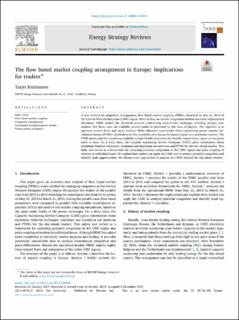| dc.contributor.author | Kristiansen, Tarjei | |
| dc.date.accessioned | 2020-08-06T14:16:10Z | |
| dc.date.available | 2020-08-06T14:16:10Z | |
| dc.date.created | 2019-12-18T07:53:14Z | |
| dc.date.issued | 2019 | |
| dc.identifier.issn | 2211-467X | |
| dc.identifier.uri | https://hdl.handle.net/11250/2671127 | |
| dc.description.abstract | A new method for congestion management, flow based market coupling (FBMC), launched on May 21, 2015 in the Central Western European (CWE) region. Prior to this, no similar congestion method has been implemented elsewhere. FBMC models the electrical network, considering cross-border exchanges including security constraints. The flows span all available parallel paths as governed by the laws of physics. The objective is to optimize market flows and social welfare. FBMC allocates cross-border flows considering power transfer distribution factors (PTDFs) which describe the sensitivity of a change in import/export at a particular country. The PTDF matrix and the remaining available margin (RAM) determine the feasible transmission region at any given point in time. On a daily basis, the Capacity Auctioning Service Company (CASC) gives information about maximum bilateral exchanges, minimum and maximum net positions and PTDFs for the day-ahead market. This daily tool serves as a framework for analyzing potential congestion in the CWE region and price coupling of markets in individual hours. We explain how traders can apply the CASC tool to analyze potential congestion and identify trade opportunities. We discuss some approaches to analyze the FBMC beyond the day-ahead market. | en_US |
| dc.description.abstract | The flow based market coupling arrangement in Europe: Implications for traders | en_US |
| dc.language.iso | eng | en_US |
| dc.publisher | Elsevier | en_US |
| dc.rights | Attribution-NonCommercial-NoDerivatives 4.0 Internasjonal | * |
| dc.rights.uri | http://creativecommons.org/licenses/by-nc-nd/4.0/deed.no | * |
| dc.title | The flow based market coupling arrangement in Europe: Implications for traders | en_US |
| dc.type | Peer reviewed | en_US |
| dc.type | Journal article | en_US |
| dc.description.version | publishedVersion | en_US |
| dc.rights.holder | The Author | en_US |
| dc.source.pagenumber | 100444 | en_US |
| dc.source.volume | 27 | en_US |
| dc.source.journal | Energy Strategy Reviews | en_US |
| dc.identifier.doi | 10.1016/j.esr.2019.100444 | |
| dc.identifier.cristin | 1762260 | |
| cristin.unitcode | 7548,50,0,0 | |
| cristin.unitname | Energisystemer | |
| cristin.ispublished | true | |
| cristin.fulltext | original | |
| cristin.qualitycode | 1 | |

